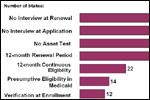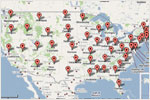Despite the economic downturn that’s busting state budgets from Sacramento to Tallahassee, 26 states this year made it easier for low-income children, parents or pregnant women to get health coverage, according to a report released Tuesday by the Kaiser Family Foundation.
But the gains could be fleeting as most were made possible by new federal stimulus dollars, which run out at the end of 2010, along with a requirement that states maintain Medicaid eligibility levels. The report surveyed how states were handling Medicaid and the Children’s Health Insurance Program.
States also benefited from the federal reauthorization of the CHIP program last February which gave them new options to expand eligibility and millions of dollars to find uninsured kids.
Diane Rowland, executive director of the Kaiser Commission on Medicaid and the Uninsured, said the report shows “there is substantial momentum to covering children,” even exceeding previous years when the economy was healthier. “I was surprised what is happening given the depths of the recession.” (Kaiser Health News is part of the foundation.)
Most of the changes were centered on children. Nineteen states last year made it easier to enroll kids in CHIP and Medicaid by increasing eligibility, simplifying enrollment procedures or eliminating premiums.
At the same time, though, 15 states scaled back coverage of children under the CHIP program, including California and Tennessee. Both froze enrollment, although California later reopened the program. As a requirement to get stimulus funding, states were prohibited from cutting Medicaid eligibility.
The future of CHIP is unclear. Health overhaul legislation passed by the House repeals the program in 2014 and rolls children and pregnant women into the new health insurance exchanges. The Senate bill continues CHIP, though at funding levels which child health advocates called inadequate.
States’ current efforts at expanding coverage are being closely watched because they will determine the “base at which the broader health reforms can be built,” said Donna Cohen Ross, director of outreach at the nonprofit Center on Budget and Policy Priorities, which helped prepare the report.
Some findings from the report:
— Eighteen states expanded eligibility for health coverage, including increasing income eligibility or reducing the waiting periods for children to be uninsured before qualifying for CHIP.
— Seventeen states and the District of Columbia have agreed to cover immigrant children or pregnant women who have been legally in the country less than five years.
— Fifteen states simplified enrollment or renewal procedures for children, parents and pregnant women by allowing them to retain eligibility for one year, removing asset tests and reducing income verification requirements.
— Two states, New Jersey and Rhode Island, eliminated premiums for some families with children in the CHIP program.
But 14 states increased premiums in their CHIP program, including Arizona, which doubled its monthly premiums. And four states — California, Colorado, Pennsylvania and Virginia– severely cut or eliminated funding to do marketing or other efforts to identify and enroll uninsured children.
“This report affirms what we have been seeing in that even with the states really struggling with budget crises, their commitment to kids remains very strong,” said Alice Weiss, program director at the National Academy for State Health Policy.
But Weiss warned that states could grow more cautious in expanding coverage because of the uncertainty over CHIP’s future. “There is a question of whether states will want to invest in CHIP for the remainder of the life of the program,” she said.








